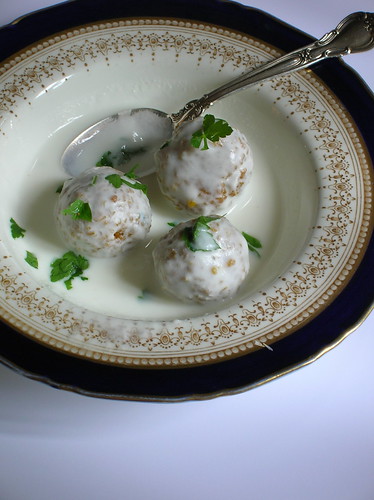
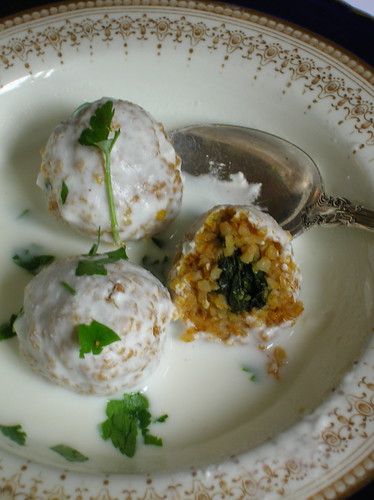
A friend and I were discussing recipes the other day, “wait a minute,” she said as I described a Middle Eastern pumpkin and spinach dish called kibbe yakteen, “I thought kibbe were little meatballs,” she asked. I paused, trying to describe how such a wide variety of dishes could all be called kibbe. Kibbe, one of the most venerated dishes of the Levant, is most commonly defined as a mixture of bulgur and ground meat usually in meatball-form. Bulgur, a by-product of the wheat harvest, is native to the areas of Lebanon and Syria where the dish is most common. But to call kibbe a meatball is to underestimate its crispy moist flavor and bypass its many variations. I think it is more useful to think of kibbe in specific terms, so I’ve come up with the following formula:
KIBBE FORMULA
__________________________________________________________
Outer Layer
Knead together filler+ bulgur + seasoning
filler options: ground beef/lamb, ground fish, pumpkin, potato, red lentils, semolina
_________________________________________________________
Inner Layer
Saute together filler + seasoning + nuts
filler options: ground beef/lamb, caramelized onions, spinach, potato-herb, yogurt
_________________________________________________________
Technique
stuffed meat balls (deep fry or poach)
layered in a tray (bake)
raw kibbe (meat only, omit stuffing)
_________________________________________________________
Other Options
yogurt sauce, cherry sauce, quince-okra sauce, tomato-tamarind sauce, chard and walnut sauce, carrot-pomegranate sauce, beet-plum sauce, kishk sauce, poached in broth as soup, etc.
_________________________________________________________
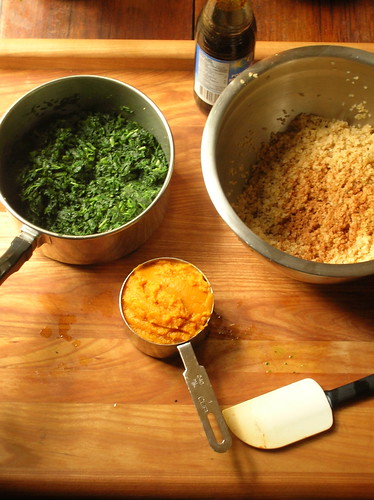
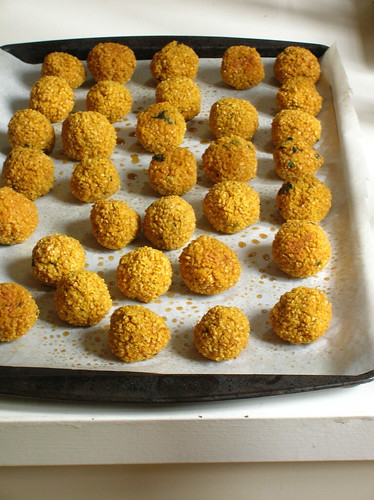
The most common form of kibbe uses meat in both parts: a meatball with an outer layer of ground meat and bulgur and an inner stuffing of sauteed ground meat and pinenuts. This is probably how you may have encountered kibbe in a restaurant- little torpedo shaped stuffed meatballs (British soldiers joked kibbe were Syria’s missiles during WWII). However, the “kibbe formula” can be extrapolated into all sorts of variations, the city of Aleppo alone claims sixty of them, including little meatballs in cherry sauce. In Tripoli, on Lebanon’s coast, ground fish and bulgur make up the outer shell, which is stuffed with a mixture of caramelized onions and pine nuts. Kibbe can also be baked in a tray, like a meat pie, and a popular version involves a potato crust and meat filling that’s evocative of shephard’s pie. Some kibbe have names associated with cities, like Nablus or Mosul, while others have names like “monk’s kibbe,” or “tank kibbe,” named because it’s so heavy, or “imposter kibbe,” a meatless version. And though somewhat outside the “formula,” no discussion of kibbe would be complete without mention of kibbe nayieeh- raw beef and bulgur pounded together, like a Lebanese tartar.
 Keep in mind bulgur continues to absorb liquid as it sits- I didn't photograph the pie until several days after making it, hence the slightly more nubby texture seen here.
Keep in mind bulgur continues to absorb liquid as it sits- I didn't photograph the pie until several days after making it, hence the slightly more nubby texture seen here.While kibbe is generally synonymous with meat there are many vegetarian versions, they were probably developped by Christians of the region who fast during Lent, but are also a good option for poor families that cannot afford meat. Which brings me back to that pumpkin and spinach recipe I referred to earlier. This unique Lebanese dish is comprised of pumpkin-bulgur dumplings stuffed with spinach and walnuts; I’ve chosen to serve it in a warm yogurt sauce, my favorite tangy counterpart. I realize that this discussion may seem esoteric, but in reality you can find all these ingredients at your local grocery (bulgur is often sold as “tabboule mix”). If you make the dumplings there’s no getting around the fact that it is time consuming, though it’s not particularly difficult. However, you can also make this in a casserole dish (I’ve done both here to demonstrate), in which case it comes together in mere minutes, and it smells wonderfully of pumpkin pie as it bakes. While I love the presentation aspect of the dumplings, the pie tastes equally as good and certainly wins when it comes to ease of preparation. My main piece of advice is not to skimp on the seasonings, it would be a shame to have such a beautiful dish risk being bland.
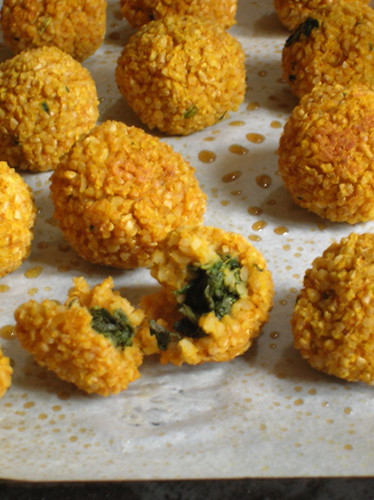
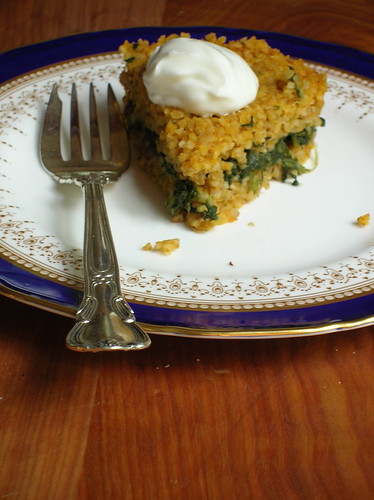
If you're new to kibbe, I suggest you try one of the more classic versions I've linked to above or head to a local Lebanese restaurant, but feel free to dive right in with this seasonal pumpkin version. And if you have a favorite version of kibbe or kibbe experience, please share it in the comments!
 Pumpkin-Bulgur Dumplings with Spinach Stuffing in Yogurt Sauce
Pumpkin-Bulgur Dumplings with Spinach Stuffing in Yogurt SauceThis is a beautiful and unusual Lebanese dish. You can make it in dumpling form, but it can also be baked like a casserole for an easier version, both are delicious. Bulgur is often sold as "tabboule mix" and is available in most groceries. Make sure to season generously. Serves 6.
for shell:
2 cups (10 oz) fine or medium-fine bulgur (often sold as tabboule mix)
1 1/2 cups pureed pumpkin (canned or homemade)
2 tbl grated onion
3 tbl flour
1 tbl cinnamon, 1/2 tsp allspice, 1 tsp salt
1 tsp Aleppo pepper or paprika
for stuffing:
olive oil
2 cloves garlic, minced
16 oz fresh spinach (can substitute frozen)
1/4 cup chopped walnuts
2 tsp pomegranate molasses or lemon juice
oil for frying
for yogurt sauce:
1 quart plain yogurt
1 clove garlic
1 squeeze of lemon juice
1 egg white
1 tbl cornstarch or flour dissolved in 2 tbl water
1. Make stuffing: Heat a glug of olive oil in a saute pan. Add the garlic cloves and saute for a minute to soften. Add the spinach (you may have to add it in batches to get it all to fit) and saute over medium heat for several minutes until wilted and dark green. Season with salt and add the walnuts and pomegranate molasses and toss to combine. Set aside to cool.
2. If you have fine bulgur (the consistency of cornmeal) you do not need to soak it. If you have medium-fine bulgur, pour hot water over it to cover. Let sit for five minutes, then drain thoroughly (I drain it in a cheesecloth lined mesh colander).
3. Combine the bulgur with the pumpkin puree, onion, cinnamon, allspice, salt, Aleppo pepper and flour. Using damp hands knead everything together for 5 minutes, until the mixture is cohesive. Let the mixture rest for 10 minutes. Knead the mixture one more time to combine- it should be more cohesive after resting, if it is too dry you can add a touch of water to loosen, or if it is wet add a bit of flour, though neither of these should be necessary.
4. Form the dumplings: Work with damp hands to prevent sticking. Flatten a heaping tablespoonful of the pumpkin mixture in your palm, place a teaspoon of spinach filling in the center, then close up the pumpkin mixture around it. Place on a baking sheet and continue forming dumplings.
5. Place oil in a deep pot for frying. Heat the oil to hot (355 F) and fry the dumplings, a few at a time, for 3-5 minutes, until golden brown. Remove with a slotted spoon and drain on paper towels. Continue frying remaining dumplings.
6. Make yogurt sauce: Using a mortar and pestle or in a small bowl, smash the garlic clove with the lemon juice and a pinch of salt. In a saucepan off the heat, combine the yogurt, garlic mixture, egg white and dissolved cornstarch, stir the mixture gently until it is very well combined, smooth, and shiny. Place the pan on the burner and cook over medium heat, stirring constantly (do not stop stirring or it might curdle). Let the mixture come to a boil and simmer for a couple minutes (at this point you can consider the yogurt stabilized and relax the stirring somewhat). Thin the yogurt sauce with water to your taste (I use about one cup but use your own judgement). Remove from the heat.
7. Combine the yogurt sauce and the dumplings in a large serving vessel, or divide among serving bowls. Sprinkle with chopped parsley and serve immediately.
To make a pie:
Preaheat the oven to 350 F. Grease a 9” round pan generously with butter. Follow directions in steps 1-3 to make the pumkin and spinach mixtures. Place half the pumkin mixture in the bottom of the pan, spread the spinach mixture over top, then cover with the remaining pumpkin mixture. Score a diamond pattern on the top of the pie. Melt four tablesppons of butter and drizzle it over the top of the pie. Bake 30-35 minutes, until fragrant and golden brown. Serve in wedges, with plain yogurt on the side.
________________________________






23 comments:
I've had many kibbe in my life...but never in cherry sauce. Sounds very yummy.
i just found your blog today and i love it.
thanks for the great vegetarian kibbe ideas.
xo
kittee
love the color combo's!
Do you have recipes for those sauces you listed? I couldn't "wing it", since I haven't heard of them before.
Thanks
S
Rachel- the cherry sauce is very common in Aleppo, they use a kind of sour cherry. They also make kebabs with lamb and cherries.
Kittee- thanks, I think you'll find lots of vegetarian ideas here.
Amanda- thanks!
Anon.- yes, I do have recipes for all the sauces listed, obviously I didn't want to type them all up, but if you let me know which ones you're interested in I could post them or email them to you. A few of the ones mentioned are available in other cookbooks (like those by Paula Wolfert, Annisa Helou, and Poopa Dweck) also.
I have been wanting to try kibbe for awhile. Armed with your "equation" I am going to have a go at it this weekend. Thanks!
Have I told you how much I love your plates? A lot.
Here's a recipe for Lamb and Cherry Kabobs(kefta bi karaz) I referred to above (not really kibbe, but quite tasty).
Callipygia- I'm glad you're going to try it! However, I wouldn't just take the formula and mix things up willy-nilly, especially if you haven't made kibbe before. The equation is more of a way of breaking down the kibbe components. There are specific combinations that are classic- for example fish with caramelized onions, or lamb with lamb, so I'd recommend you try one of the classics first before you start experimenting.
I didn't know about the casserole option! And I love the idea of the cherry sauce - would that be served with a meat version at all? I imagine it's delicious.
Luisa- ha, I was just thinking people must be really tired of looking at these plates (I do own others, you know). My mom has about a zillion, and I am slowly inheriting some of them. They're Royal Worcester Regency in cobalt blue, and they far outlasted the marriage they were registered for.
Amanda- yes, the casserole version is very popular (in Arabic it's bil sayanieh). The cherry sauce is almost always done with meat, usually lamb. It uses a sour cherry that's found around Aleppo, and also check out the kabob version I linked to in the above comment.
such an informative post! I love your blog.
Sooo beautiful - I love your blog!
hi,
how do you make pumpkin puree from scratch..we dont get any packaged in india.
Anon-
I've put a link in the post for making homemade pumpkin puree. Basically, what you do is cut the pumpkin (or any other winter squash) in half and roast it cut-side-down in the oven until very tender. Scoop out the flesh and puree it. Then, place in a chessecloth-lined colander and drain overnight. The draining part is very important, particularly for this recipe, because if the puree is too watery the pumpkin-bulgur-dough won't hold together.
Beautiful!
Thanks for sharing this. I'm from Turkey and recently visited Syria twice, seeing all those similar dishes (same goes to Egypt, Lebanon, Israel etc) makes me feel these countries were like sieblings in the past. I hope food will bring them together again.
this is so wonderful--I am such a novice kibbe cook. I'm still trying DESPERATELY to learn how to make kibbe batata (or kubba batata as I know it), with a potato shell. the shell keeps disintegrating when I go to fry it! I am thinking of adding egg to the shell, but I am told that egg is not a part of the shell ingredients. bleah. :)
anyway--your kibbe look so beautiful.
Wow, Mercedes! Your photos are beautiful, and I learned a lot about kibbe here. My in-laws introduced me to rice kubba, and I'm trying to learn all I can...there really aren't many sources of info on the web about it, and your post is a gem.
can another squash be substituted for the pumpkin? I also would be interested to know how to make the potato shells so that they don't disintegrate when frying!
Hi Mercedes! I never knew about this yummy combination (I was raised on the regular lamb/ground beef with bulghur type--both raw and cooked). I changed it a little by using cooked millet instead of bulghur (wheat sensitivity), and a collard greens/tahini/lemon juice filling--delish! Now I have a kibbeh to go with my vegetarian dolmades for Thanksgiving! (My late grandmother was Lebanese, so any holiday=grape leaves, kibbeh, hummus and pitas)
I love pumpkin kibbe and made your recipe for the first time tonight (with the addition of chickpeas to the filling, which I got from another recipe) -- it was fantastic! My bf who claims to hate both pumpkin and spinach loved it and asked for seconds...thanks!
Hi! I loved your article and made your recipe (using butternut squash instead of meat or pumpkin). Photos at http://tinyurl.com/yhdrxuc and http://tinyurl.com/ygesvtd.
Thanks, Julia.
hey! is it possible to bake the pumpkin kebbe ( the balls) or whats the deal with poaching...do tell!looking for a healthy version...and i do hate frying as its messy. do u know about tefal actifry? would that work? or would it fall apart
Your Kibbe recipe looks delicious. I would like to try it with the beet-plum sauce that you mentioned. Could you please email me the beet-sauce recipe at maguerrero22@yahoo.com. Thank you!
Post a Comment